The history of electrotherapeutics has presented a long legacy of scientists, researchers, and physicians determined to illustrate the connection between healing, rejuvenation, and electrical current. Ancient Egypt, Greece, and Rome utilized electric eels in therapy for headaches and neuralgia, which was indeed primitive but reputedly effective as it was applied throughout various practicums throughout history.
Intensive research by scientists such as Björn E. W. Nordenström have made enormous contributions to the pursuit of associating electricity and healing. Nordenström, while a member of the Nobel Prize Committee in 1983 at Karolinska Institute in Stockholm, Sweden, illustrated that infected or injured tissues, as well as healthy tissue, generated electrical stimulus potential that is not related to the nervous system’s electrical activity.1 Dr. Robert Becker of the well-reputed work on electrotherapy: The Body Electric has also illustrated that endogenous electricity, along with adaptations in the polarity of tissue elicited through injury or illness, may actually denote the primary mechanism of the healing process.2 Microcurrent remains immensely popular in the medical and aesthetic field, presenting a staggering number of devices and apparatus professing skin refinement and tightening. Science plays a dominant role in microcurrent with regard to physics, biology, and electricity – there are variables that corroborate a true microcurrent application and the possibility of achieving anticipated results.
Electrical Current in Practice
The primary types of electronic stimulation used in health, sports medicine, and cosmetology are:
- Electrical Muscle Stimulation (EMS) – Often called e-stim, are devices that create different “waveform” outputs, operate in different cycles, and focus on muscle stimulation, contraction, and re-education.
- Transcutaneous Electrical Neuro Stimulators (TENS) – Electrical stimulation based on milliamps delivering current to the skin with intent to block nerve pain signals from transmitting to the brain. TENS devices stimulate sensory nerves and endorphins and help to reduce the sensation of pain.
- Interferential Current – Represents two different electrical currents crossing over each other through tissue to stimulate large impulses. Interferential offers deep penetration, combined with increased comfort and circulation. It is primarily used for joint injury, trauma disorders, and pain.
- Russian Current or Russian Muscle Stimulation – Designed to stimulate motor nerves and has a much higher electrical frequency, deeper muscle penetration, and stronger contraction of the muscle fibers. Russian current is used primarily for building muscle and injury rehabilitation.
- Sinusoidal or Diadynamic Current – This current has two waveforms, MF (monophase) and DF (diphase), that may be used singularly or in tandem. The current generally produces a surged rhythmical muscle contraction and is typically used for large areas (body) and considered not ideal for specific facial muscle application due to the tingling sensation and stimulation of the motor nerves.
- Faradic Current – An alternating and interrupted current, producing a mechanical reaction. It is often referred to as “passive exercise,” as it noticeably can cause muscles to contract involuntarily. It can generate erythema, increase metabolism and circulation, and has been used for many years in cosmetology with great popularity in Europe.
- Galvanic Current – Based on the concept of galvanism is a direct, constant, unvarying current. Current is delivered with electrodes reacting as a positive and negative force to create chemical or physiological effects. Galvanic current reacts on sensory nerves and motor nerves, instigating a prickly or stinging sensation and is generally used to introduce solutions into the tissue (iontophoresis) or for disencrustation. It is recommended to avoid the use of “facial toning” devices that have a ramping or surged direct current, as these may lead to tissue burns and minimal or no muscle contraction, particularly on thin or sensitive skin.

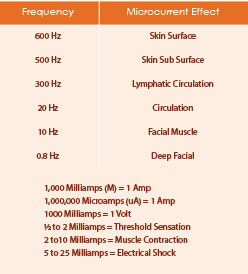 Microcurrent Electrical Neuromuscular Stimulation (MENS)
Microcurrent Electrical Neuromuscular Stimulation (MENS)
The body has a continual flow of resonating electrical impulses that transmit signals through living tissues, utilizing electrons, chemicals, and electromagnetic bonds. The body’s tissues are lined with water-hydrated matrixes that act as semiconductors to permit the transfer of electrons and communicate specific frequencies. Each cell, tissue, and organ has its own specific frequency that synchronizes its activity within the body. Microcurrent is aligned to support the intricate biological and physiological phenomenon that has been exhibited throughout electrotherapeutics in clinical history – electricity will take path of least resistance as it flows through tissue.
Microcurrent utilizes micro-size, pulsating current at an ampere, one millionth of an amp, to resonate with the body’s own bio-electrical exchanges that take place at the cellular level. The majority of other types of electrical current stimulation devices (sinusoidal, faradic) bypasses cellular activity and focus primarily on tissue, fascia, and muscle. When microcurrent is applied, it triggers impulses to facilitate a chemical reaction to activate the release of adenosine triphosphate (ATP) at the cellular level. Adenosine triphosphate is a high-energy molecule that is in the mitochondria of a cell is considered the “energy of life.” As adenosine triphosphate is collected and generated into muscle, it may use this energy to ‘communicate’ muscle re-education or other specific attributes from microcurrent.
Microcurrent delivers less than 500 microamperes, is bi-polar, and is considered sub-sensory, implying that the intensity does not cause any visual jolting muscular movement. Sub-sensory activity also implicates that the recipient of the treatment should feel no “sensation.” If sensation is detected, the frequency is set too high and there is an inadequate amount of conductor gel applied or possibly the current is other than microcurrent. Water-based conductor gels should be used with microcurrent and applied evenly and densely to ensure effective conductivity. Microcurrent also facilitates iontophoresis of water-based products into the skin, such as nutritive serums or ampoules. The natural course of Ohm’s Law permits this penetration from one probe to the other, penetrating through the skin, allowing effective product absorption.
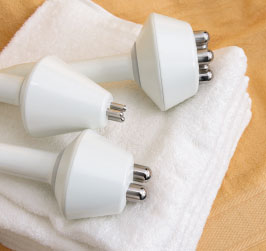 Ohm’s Law
Ohm’s Law
The amount of current flowing through tissue is dependent on voltage and resistance of the tissue in which the electricity is carried through. Current has to flow through the electrode, though gel or water, penetrate the skin, transfer through underlying tissue, then flow back through to the other electrode. These variables determine the impact the current will have on the skin, muscle, or tissue and resultant application. It should be noted that the resistance of subcutaneous tissue is low because of surplus water, whereas the stratum corneum is highly resistant due to its physiology and transepidermal water loss.3
The greatest resistance for electrical impulse in the body is fat and bone – muscles and nerves have the least resistance. Resistance will also vary from person to person and the skin itself. Microcurrent is delivered at a range where it is not able to incite nerve response, but rather impacts biological activity. Current that is “bioelectric” is usually in the microamp range as it is able to allow for more effective ion transport, which, in turn, increases cell metabolism and energy to occur within muscle fibers.
The Schultz-Arndt Principal
Microcurrent supports the 19th century pharmacologic principle of homeopathy discovered by scientists Hugo Schulz and Rudolf Arndt. It identifies that weak stimuli will accelerate physiologic activity, medium stimuli inhibits physiologic activity, and strong stimuli ceases physiologic activity.4 In simpler terms – less is more. Many people might misconstrue the thought that ‘bigger is better’ with electrical current and that it will provide more rapid and drastic results. On the contrary, aggressive current has been known to cause discomfort, actually atrophy tissue, and cause skin burns. In addition, improperly applied current of any variety can lead to energy loss of adenosine triphosphate by overstimulation through aggressive application and in some individuals, create potential for the aggravation of health conditions.
To elaborate further, electrotherapeutic physics identifies that muscle stimulation and intensity of current are aligned. The actual strength of a muscle contraction or sensory effect will depend on the number of nerve fibers stimulated, which is determined by the intensity of the current. Greater intensities of current will transpose further into tissue that will illicit nerve response. Electrical stimulation of muscle via its motor nerve has both immediate and long-term effects. Muscle contraction and vascular changes are examples of short-term effects, while muscle strengthening and structural changes in muscle fibers may ultimately result from long-term, chronic stimulation.5
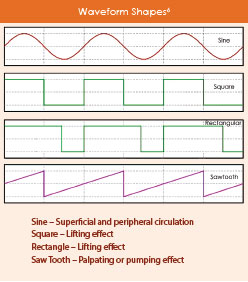 Follow the Wave
Follow the Wave
Microcurrent waveforms are a graphic representation of the path, shape, direction, and pulse of the delivery of the electrical current. A device may generate waveforms simultaneously, affecting tissue at various intervals with laxity or intensity and allowing for fluctuations in the peak delivery of the current. Waveforms permit microcurrent to penetrate the cells at various frequencies and depths, whereas direct current does not. Quality microcurrent devices use a variety of preset waveforms with currents ranging from 30 to 1000 microamps. The output frequency also varies depending on the device and a range of frequencies are selected and applied either by the operator adjusting the controls, or presets on the device instrument panel. The training manual or device schematics accompanying a piece of equipment may list frequency range, pulse duration, waveform capacity, and so on. If this information is unavailable, consult the technical support of the manufacturer.
A Nobel Discovery
The Nobel Prize for Physiology/Medicine in 1991 was awarded to Dr. Bert Sakman and Dr. Edwin Neher for their work regarding the response of microcurrent on the physiology of human cellular membranes. Microcurrent’s electrical impulses and various frequencies could instigate an open exchange in the “voltage sensitive cellular ion channels” within every cell. Cells communicate to conduct activity – microcurrent encourages “communication,” is capable of transmitting energy to adjacent cells, and provides the mechanism for propagating the electrical signals. Action potentials occur due to a rapid exchange between intracellular and extracellular ions. All cell membranes have multiple channels or gates that allow the flow of ions in and out of the cell.
Dr. Sakman’s and Dr. Neher’s research further illustrates that each cell contains between 20 and 44 different ion channels, each being specific for a particular nutrient: calcium, magnesium, sodium, and so on. They determined that electroporation of the cell via electrical stimulation could detoxify the cells through pulsation. Through electroporation it was possible to exchange both toxins and nutrients via cellular membranes. This discovery has had great implications for the medical field and represents opportunistic possibilities for the aesthetician working with problematic, oxygen deprived, or sun damaged skin.
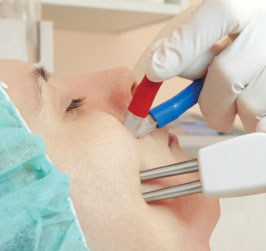 Science Tells a Story
Science Tells a Story
The well-cited studies by Dr. Emil Y. Chi, Ph.D. at the University of Washington’s department of pathology revealed that skin tissue treated with microcurrent showed a 45 percent increase in the number of elastin fibers in the dermis and, on average, the length of the fibers doubled. Collagen thickness in the connective tissues increased 10 percent, protein synthesis by 70 percent, and there was an increase in cellular transport by 40 percent. Dr. Chi’s 2003 study further noted a 35 percent increase in peripheral blood circulation and lymphatic drainage. Clinical studies performed using microcurrent at Hong Kong’s Tuen Muen Hospital in 1988 indicated that lymphatic function increased by 28 percent on post-cancer patients suffering from lymphedema.
In 1982, a study by Dr. Ngok Cheng conducted at the University of Louvain, Belgium concluded that the higher the microcurrent values, the less beneficial the effect. The research determined that when microcurrent levels were used up to 500 microamps, skin regeneration increased almost 500 percent. Between 1000 and 5000 microamps, adenosine triphosphate generation plummeted, and at or above 5000 microamps, it dropped below baseline control levels. Illustrating once again that microcurrent responds at the cellular level and with less electrical stimulation than other types of current.7
A Time for Critical Thinking
The modern clinical-based approach to aesthetics involves medical-oriented philosophies and the integration of hi-tech equipment. As the information highway moves swiftly, so does the exposure to professional products, technologies, and devices to our ever-increasingly observant and astute clients. As a result, the Internet is often perceived as a second opinion resource for many and poses the prospect of ‘information overload.’ This factor may impact the delivery of recommendations to clients and create a level of ambiguity. In the quest for aesthetic excellence, skin care professionals should also focus on delivering the most current scientific information to clients, along with the presentation of progressive equipment. The knowledge path chosen should include a commitment to recognize the importance of technical training and to learn to explore the scientific model – one of reasoning, confirmation, and confidence.
References:
1. Nordenstrom BE., (1983). Biologically Closed Electrical Circuits -Clinical Experimental and Theoretical Evidence For An Additional Circulatory System, Stockholm: Nordic Medical Publications, 112-172.
2. Becker, Robert O., Selden, Gary, (1985). The Body Electric, William Morror and Company, Inc., New York.
3. Jyothis, Dr. A.B. Ram, (2005). Arndt-Schultz Law – A Scientific Evidence, Homeopathy Times, 2(11).
4. Soo CL., Currier, DP., et. al., (1988). Augmenting Voluntary Torque of Healthy Muscles
By Optimization of Electrical Stimulation – Physical Therapy.
5. Fish, Raymond M., Ph.D., et al., (2009). Conduction of Electrical Current To and Through the Human Body: A Review – Eplasty, Open Access Journal of Plastic Surgery.
6. Electrotherapy (Cosmetic), Retrieved from http://en.wikipedia.org/wiki/Electrotherapy_(cosmetic).
7. Cheng N., Van Hoof, H., et al., (1982). The Effects of Electric Currents on ATP
8. Generation, Protein Synthesis, and Membrane Transport of Rat Skin, (171): 264–72.
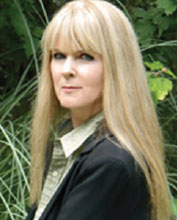 Dr. Erin Madigan-Fleck is a licensed aesthetic instructor and aesthetician with more than 30 years of experience in the aesthetic and wellness field. She is a nationally certified natural health professional, holds a bachelor’s in natural health, masters in holistic nutrition, and a doctorate in naturopathic medicine. She is an advanced educator and technical writer for Institut’ DERMed College of Advanced Aesthetics in Atlanta. She can be reached at This email address is being protected from spambots. You need JavaScript enabled to view it. or This email address is being protected from spambots. You need JavaScript enabled to view it..
Dr. Erin Madigan-Fleck is a licensed aesthetic instructor and aesthetician with more than 30 years of experience in the aesthetic and wellness field. She is a nationally certified natural health professional, holds a bachelor’s in natural health, masters in holistic nutrition, and a doctorate in naturopathic medicine. She is an advanced educator and technical writer for Institut’ DERMed College of Advanced Aesthetics in Atlanta. She can be reached at This email address is being protected from spambots. You need JavaScript enabled to view it. or This email address is being protected from spambots. You need JavaScript enabled to view it..
Want to read more?
Subscribe to one of our monthly plans to continue reading this article.